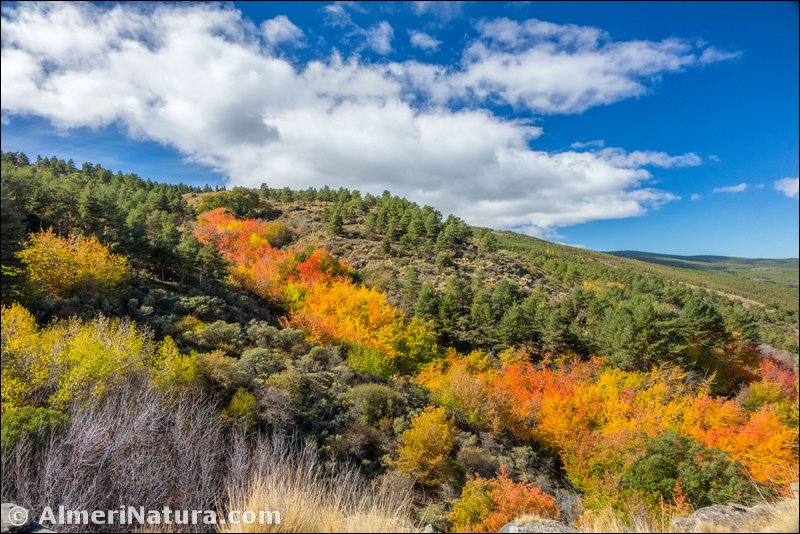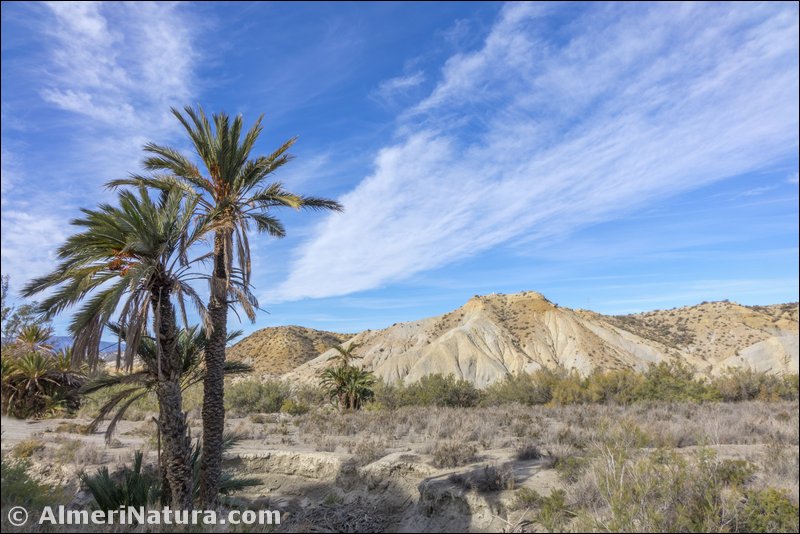The territory of Almeria is one of the places with the greatest biodiversity in Europe, where the following bio-climatic levels are represented: Oro-mediterranean, Supra-mediterranean, Meso-mediterranean and Thermo-mediterranean. Subdivided into: arid, semi-arid, dry and sub-humid precipitation zones. In addition, in each level there are three sub-levels: lower, medium and upper. Thus is configured Almeria’s bio-climatic cocktail that makes such a variety of species possible.
Due to its location, Almeria, bio-geographically belongs to the:- Holarctic or Boreal kingdom, Tetian sub-kingdom, Mediterranean region, Almerian sector and part of the Manchegan sector.
The Almerian sector belongs to the Murcian-Almerian zone, characterized by scarce rainfall, high temperatures in summer and mild winters. There are two bio-climatic levels:
- Thermo-mediterranean Level. Characterized by the almost total absence of woodland. Instead thorny and sub-desert shrubs prevail.
- Meso-mediterranean Level. In the inner areas of the province, colder with scarce rainfall. Kermes and Holm Oaks may grow here.
The Manchegan sector applies to a small portion of the province in the north: Los Velez and the flatlands of Topares and Chirivel. Its flora is a result of alkaline soils and the great difference between summer and winter temperatures. The bio-climatic levels are:
- Meso-mediterranean Level. Kermes and Holm Oaks are found here.
- Supra-mediterranean Level. Holm Oaks, Pyrennean Oaks and Kermes Oaks are dominant.
- Oro-mediterranean Level. There are pines and Junipers (Pinus nigra and Juniperus sabina).
 In broad outline, the typical vegetation in the province of Almeria is made up of Mediterranean forest. In general it is very degraded by man’s action in his economic activities that have characterized the history of the province: grazing, charcoal making, mining, agriculture, etc. The origin of this Mediterranean forest must be in the Lower Tertiary, an era from which the Pinus, Quercus, Alnus and Populus genera come. They diminished in area in successive millennia due to a general increase in average temperatures. Sclerophyllous forests were then added. Genera such as Laurus, Ceratonia (Carob) and Pistacia took refuge in Almeria during the glaciations and quaternary interglacial periods. The vegetation depends on many factors, among which we highlight rainfall strongly correlated with altitude, and the kind of soil. On the summits of Sierra Nevada and Filabres, above 1800m, the predominant vegetation is made up of broom and juniper bushes, adapted to high mountain physical conditions. While in middle mountain areas, evergreen oaks are dominant. They are also dominant in dry areas with alkaline soils, with a large area in Sierra de Gádor. In Sierra Alhamilla there is one of the most extensive and best preserved areas of evergreen oaks. The semi-arid inner areas are mainly populated by lentisc bushes which also surround the main mountainous areas. This vegetation is very degraded and very frequently turns into esparto grass.
In broad outline, the typical vegetation in the province of Almeria is made up of Mediterranean forest. In general it is very degraded by man’s action in his economic activities that have characterized the history of the province: grazing, charcoal making, mining, agriculture, etc. The origin of this Mediterranean forest must be in the Lower Tertiary, an era from which the Pinus, Quercus, Alnus and Populus genera come. They diminished in area in successive millennia due to a general increase in average temperatures. Sclerophyllous forests were then added. Genera such as Laurus, Ceratonia (Carob) and Pistacia took refuge in Almeria during the glaciations and quaternary interglacial periods. The vegetation depends on many factors, among which we highlight rainfall strongly correlated with altitude, and the kind of soil. On the summits of Sierra Nevada and Filabres, above 1800m, the predominant vegetation is made up of broom and juniper bushes, adapted to high mountain physical conditions. While in middle mountain areas, evergreen oaks are dominant. They are also dominant in dry areas with alkaline soils, with a large area in Sierra de Gádor. In Sierra Alhamilla there is one of the most extensive and best preserved areas of evergreen oaks. The semi-arid inner areas are mainly populated by lentisc bushes which also surround the main mountainous areas. This vegetation is very degraded and very frequently turns into esparto grass.
As we get closer to the coast and lower in altitude, the vegetation is increasingly arid. In the lowlands of Campo de Nijar and the Almanzora Valley, thorny plants predominate, mainly Jujube-trees (Ziziphus lotus). They give the landscape a marked desert look, partly caused by man’s activities. In this area the great floristic wealth is very noteworthy, and includes many endemic plants. In Campo de Dalias and the Andarax valley, with similar soils but less arid, thorny plants such as Artos (Maytenus senegalensis subsp. europaea), are predominant, although man’s activities, eg. crops in greenhouses, hardly allow one to see any remnants of natural vegetation. In the ranges of Cabo de Gata and Sierra Cabrera, the altitude intensifies the action of the sea and a less sparse vegetation has developed than that of the surrounding areas. Lastly, the soil formations of the Badlands of Campo de Tabernas stand out, and the gypsum formations are notable. The delta formations in the river mouths are also worth mentioning.
Like the vegetation, the fauna of Almeria has a great biodiversity and richness. In Cabo de Gata and Nijar, the fox, hedgehog, ocellated lizard (subspecies nevadensis) and the snub-nosed viper are outstanding. In Sierra de Los Velez the birds of prey, crested lark, calandra’s lark, and meadow pipit are typical. Snakes and butterflies -Parnassius apollo is endemic- are also abundant. In Sierra Nevada and Sierra de Los Filabres birds of prey and several protected mammals are also abundant, such as the mountain goat, bobcat and wild boar, amongst others.
 The natural richness of the province of Almeria is reflected in several protected natural areas:
The natural richness of the province of Almeria is reflected in several protected natural areas:
- One National Park: P.N. of Sierra Nevada, shared with Granada, where we can find mountain goats and wild boar, as well as an abundance of flora, unique in the continent.
- Three Natural Parks: Cabo de Gata-Nijar, declared in 1987 and the first maritime-terrestrial in the country. It is probably one of the last strongholds of virgin coast in the Mediterranean. It has a number of endemic xerophytic plant species and, until a few years ago, was sanctuary to the last monk seals in Europe. Another is Sierra de Maria-Los Velez. It has great areas of pines and populations of the scarce Moorish tortoise. Lastly the Sierra Nevada again, those areas under 2000m.
- There are also five Natural Areas: Alboran, Desert of Tabernas, Karst en Yesos de Sorbas, Punta Entinas-Sabinar and Sierra Alhamilla. The most important of them might be considered to be the first two Natural Areas: The Desert of Tabernas is technically the only desert in the European continent. It is an exceptional ecosystem and its peculiar landscapes have been used by the cinema industry from the beginning of the 60’s. The nearby Karst in Yesos of Sorbas is a complex of caves, canyons and other karstic phenomena carved by the Rio de Aguas in a deposit of gypsum near the village of Sorbas.
- Two natural reserves: Albufera de Adra and Punta Entinas-Sabinar.
- Six natural monuments: Reef of Barrera de Posidonia, Island of San Andres in Carboneras, Island of Terreros and Isla Negra in Pulpi, Piedra Lobera, Sabina Albar in Chirivel and the geode of Pulpi.
- And a peri-urban park: Castala in Berja.
- Another remarkable natural features in the province are the giant olive tree in Agua Amarga, one of the most long-lived in the European continent.
- There are also several centers of recovery, conservation and study of fauna and flora in the province. Some of them are:
- The Rescue Park of Saharian Fauna in Almeria.
- Botanic Garden of Albardinar in Rodalquilar (Nijar).
- Botanic Garden of Umbria de la Virgen in Maria.
(Adapted and translated from Wikipedia)



